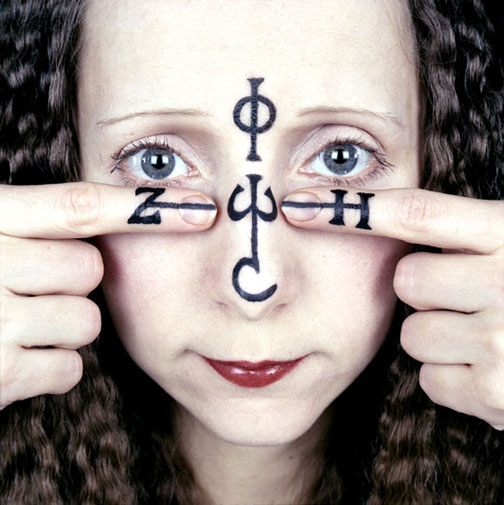
< home < content next: part 3 >
RIMMA GERLOVINA AND VALERIY GERLOVIN
PHOTOGLYPHS
© 2010, Rimma Gerlovina and Valeriy Gerlovin
PART 2
Although we photograph faces, the resulting works aren't portraits, the reason being that we use not models, but modules, similar to those in our album Semantics of Possible Worlds, created in 1977. Metaphorically, the module personifies different states of psychological and visionary experience; despite its multiple guises, it exists in a unitary image. There is, or at least has to be, some kind of concord between the micro-world of each atom in man and the macro-world of the universe (as articulated by the Hermetic dictum "As above, so below," among others). According to this view, one may express the universal through the human presence, reflecting "the face" of the world in man's face and dimensions - an embodiment of the principle that we exist in all that exists. Therefore, instead of photographing all that exists, we photographed its representations, using ourselves as modules. Precisely in such context, Greek Formula (1990) depicts a cruciform monogram composed of the two Greek words meaning "light" (phos > photos) and "life" (zoe > zoo).

Rimma Gerlovina and Valeriy Gerlovin, Greek Formula: The cruciform monogram composed of the Greek words for light (phos > photos) and life (zoe > zoo) © 1990, C-print. |
The image signifies the descent of the creative impulse of light into life-forming matter. Empirically, light is unmanifest until it passes through something; matter is that something, which is conductive to its manifestation. When endless creative potential descends into the relative, hence transitory, phenomenal world, it supplies this world with the vital impulse. Upon entering life, light becomes the world. The state of the equilibrium of the opposites is rarely stabilized on the physical plane. Through all these variety of forms light appears to be "pinned" to the tree of life, which has many twigs and knots. The process of fecundation can be expressed with the minimum words:

Light is constrained in matter > life appears and disappears > everything is recycled. The lower grades represent some sort of compost that is constantly reprocessed and reconverted into a new life, consequently refilling that very compost. The perpetual motion of the great breath of life and all-fertilizing light are interrelated. The ray of light contains the entire spectrum ("spectacle" in Latin.) The retina of the human eye responds only to light from 780-nanometer length of red color to 390 nm of violet from the entire unbounded spectrum. Everything else beyond these numbers would be infrared or ultraviolet, inaccessible to the eye of flesh that can see no more than the physical and sensory world. Only the eye of mind is capable of distinguishing some other ranges on the symbolical level.
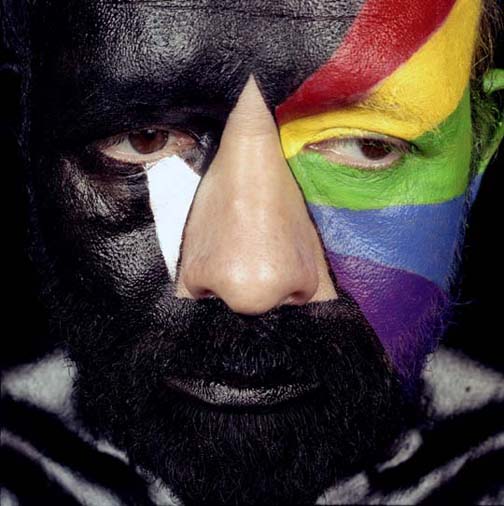
| Rimma Gerlovina and Valeriy Gerlovin, Spectrum © 1989, C-print. |
In our spectral analyses painted on the face, the prism of the nose "chisels" the rainbow of the world, refracting light into a bundle of colored rays. Psychologically the prism of the ego might serve as the vehicle not only for the separation from the essential source, but also for the projection of the spectrum. As it is known, a photon, the ultimate unit of light in physics, can be seen only once, because its detection brings its annihilation. May it be that light is rather seeing than something to be seen? And what is then the entire spectrum? A dream that is dreaming itself?

| Rimma Gerlovina, Self-Port: The work is shown in two positions, in rest and in rotation that blends all colors. 1987, wood, acrylic, 23 x 16 x 4". |
Rimma's shifting object titled in brief, Selfport (1987) is based on the well-known law of physics: when the circle is in a static position, the colors of the spectrum are perceptible; if the head is rotated, the spectrum becomes blurred and fused into gray. The swifter the rotary, the grayer the spectacle becomes. Speedy life obstructs distinction of things; with this, we enter a circle of manifold restless motion of the world as though obeying a mechanical law. Each goal is followed by another one in an endless strive to win. Whirling thoughts, chance meetings, incidental events - all pour into the head from every direction and swarm like ants. An inward pause can break the force of mundane conditioning revealing the spectrum of intuitive faculties. One has to slow down and keep a moderate pace, neither succumbing to inertia and latency in the arms of Morpheus, nor turning into one of the units of a restless activity of mass consciousness.
Reverting to Greek Formula, we would like to add that despite its archaic lineage, it is not only a sublime idea or a pure abstraction; it's a living symbol not less now than before. Naturally, such an approach to the word as a living entity requires some imagination. However sublime the word (or logos), people experience it in the here and now in a variety of forms, not confined to verbal interpretations. What happens in our case is that we "reface" and recharge these forms with human expressions, while other artists use other media. If each concept contains plurality within itself, the word "believe" would be a vivid morphological illustration of that notion.
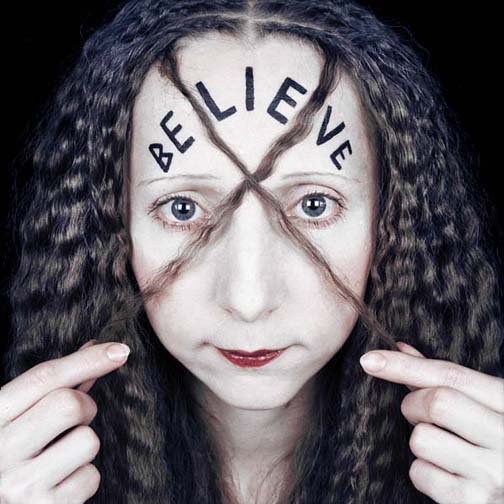
| Rimma Gerlovina and Valeriy Gerlovin, Be-lie-ve, ©1989, C-print. |
Deploying that watchword, the image Be-lie-ve encapsulates both a mode of thought and a set of beliefs in its paradoxical duality. When word becomes flesh, it's possible to treat or mistreat it as such. In the Acts of John, one of the early Apocrypha, there's a poetic passage about the torment of the Word, the piercing of the Word, the blood of the Word, the passion of the Word (97:102). In that manner, we literally dissected the word on the forehead with the help of locks. By demonstrating the treason of falsity, the word was forced to reveal its contradictory core, being almost doomed by the interpolated magical spell of "lie." Should we be-lie-ve in its central component or pursue another manner of seeing? In whatever context, be it politics, religion, or art, the hypnotic hypocrisy is forever concealed in that binary. A lie can come in the form of a truth, and a truth can come in the form of a lie. Be-lie-ve it or not. Through words, we can arrive anywhere, but not necessarily at the truth. The Sufi master Mullah Nasreddin once said, "I never tell the truth." If this is true, it contradicts his statement. But if he was lying, as he indicated, it means that he really was telling the truth.
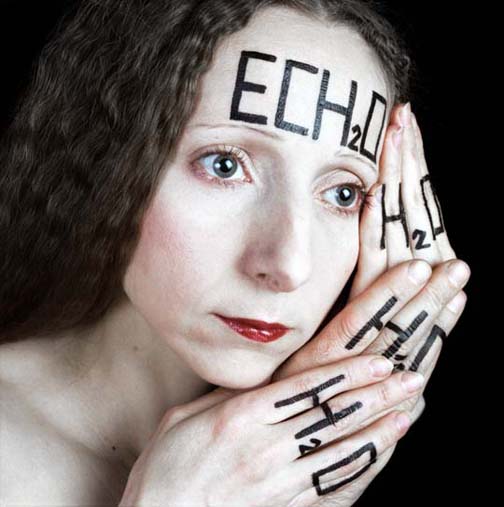
| Rimma Gerlovina and Valeriy Gerlovin, Echo © 1989, C-print. |
Aphoristic intensity can act like a vitalizing breath, hinting at absoluteness in the midst of absorbing relativity. The world is full of brain-spinning, hindering, and confusing events, which often act as a paradox within a paradox. Both the sea of irrationality and the wind-driven ship of fools are our brain-testers. Yet, it would be unreasonable to ask the reason to explain the unreasonable. Naturally, this returns us to the same loop of paradoxes, the navigation of which certainly requires a sense of humor. It helps us float over that loop, to avoid sinking in its absorbing flux. More than this, some people prefer to tell the truth, laughing as Voltaire did in order to "keep himself from going mad." Master of his craft, Voltaire could transfix a personality with an epigram like a butterfly on the head of a pin. The idea of deploying humor toward virtuous ends is not new. Besides, laughter is often described as the world's oldest therapeutic remedy; it refers all things to our incomplete self, thus stimulating the desire for completion. Taken far enough, humor can harmonize and transform a serious metaphysical message, turning it into a physical and metaphorical one, so that one can partake of a joke without devaluing the initial idea. Both its verbal and visual content might help resolve the paradoxes hidden behind the limitations of life. As a counterpoise to them, we tried to use "sense" to unite "essence" with "nonsense," depicting this operation in our work of that very title.
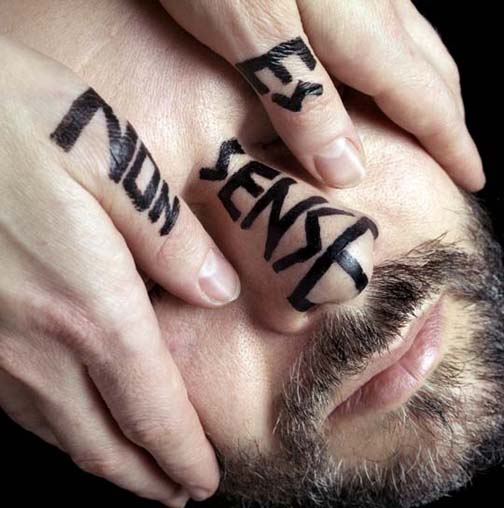
| Rimma Gerlovina and Valeriy Gerlovin, Sense © 1989, C-print. |
However, any aphoristic devices have to serve the purpose of meaning. They're useless if they're deployed purely for the sake of their eye-catching eccentricity, adding even greater perplexity to an already perplexed-enough world. The same can be said of irony bordering on cynicism, which has become an unfortunate syndrome of our time. The low-key nature of modern art is that it draws attention mainly to deconstructive realities and primary instincts, feeding largely on the artist's ego drives. Even if cynicism arises out of legitimate bitter experience, age, or exceptionally keen observation, it remains the same - indulgence in captiousness and annoyance that only adds to the sorrows of the world. If carried to an extreme, cynicism may even paralyze the consciousness. To add a further twist to the spiral of paradoxes, cynics are often very well adjusted in the very society that they regard with irony and contempt. Successfully criticizing popular trends, they play on that very cynicism of our self-indulgent culture. As the two extremes often come together, cynics might agree with the bold optimism of Leibniz's famous dictum that we're living in the best of all possible worlds. There arises the natural question, "In what way?" The answer: because all other worlds might be even worse. Consequently, it should be added that only in a state free of the striving of opposites, one is exempt from their contradictions and ensuing suffering, in which "this best of all possible worlds" is imbedded. Therefore, the mastering of paradoxes that neutralizes their just and unjust causes seems to be a prime necessity for a sovereign intelligence in the given reality.
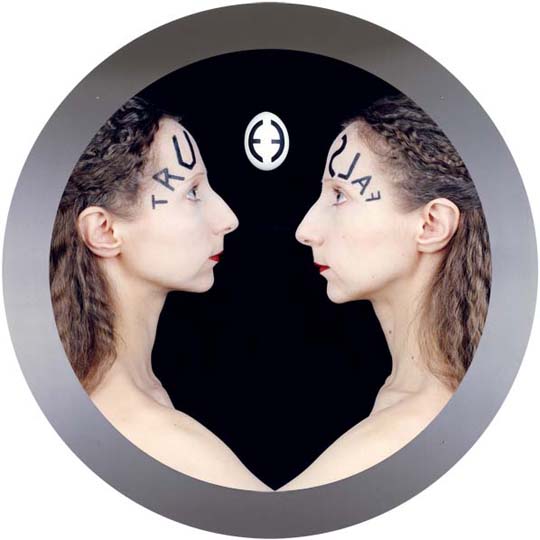
| Rimma Gerlovina and Valeriy Gerlovin, True - False © 1992, C-print in stainless steel frame, diam. 48". |
The casuistic duality of nature can be illustrated by many means: the play of words, numbers, events, and, naturally - the egg. Analytically, the egg is an organic end that hatches its own beginning. That very conundrum is demonstrated in the mirror composition True - False (1992). If in Be-lie-ve the central "lie" serves as a radioactive element for its X-ray, here that role is ascribed to the egg. With symmetrical dignity, the two profiles, like two sides of a coin that has one coinage, bear the inscriptions "true" and the backward "false." The two meanings are compared in disputation, making it impossible for both to be true or both false. The egg seems to retain the mystery of a solution.
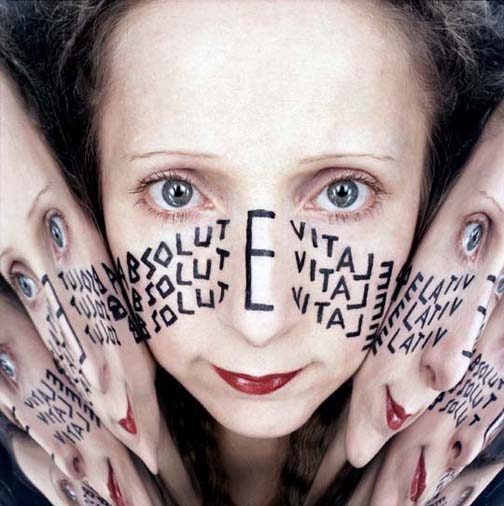
| Rimma Gerlovina and Valeriy Gerlovin, Absolute - Relative © 1990, C-print. |
On a more abstract level, a similar binary is demonstrated in the composition Absolute - Relative (1990), where these two words (the latter of which is inverted) are simultaneously shown in a state of war and peace. Now if we take the endings of both words as a unifying point, the letter "E," accepted as a conventional glyph for energy, would already seem to hint at the answer. Using multiple reverberating mirrors creating a corridor of similar images, we linked these two notions through their mutual energy, extending it into both sides ad infinitum. To boil down the explanation to a couple of thoughts: energy molds matter - absolutely and relatively - and the concentrated mind is able to use energy. Hence, the entire "mathematical" drama is envisioned on the human face. In a way, it's a picture of multiplications of thoughts going in both directions: toward the absolute and toward the relative. They're like two ends of a rope; the one inevitably follows the other. And both ends go off into infinity. They're similar to complementary black and white, which are located on one line, extending on both ends. One has to master the entire range in order to understand their hues and extremes: from the black "non-color," the root of all shades, to the white "supra-color," the synthesis of the spectrum. Apparently, deep wisdom is realized only with knowledge of its opposite. This same reciprocity can be expressed philosophically in Sanskrit terms: for the ancient Indian mind, it was the usual state of the world when dharma (the right way) was always accompanied by maya (the illusion of creation). That state of the world is still the same, and apparently will be readily available in the future.
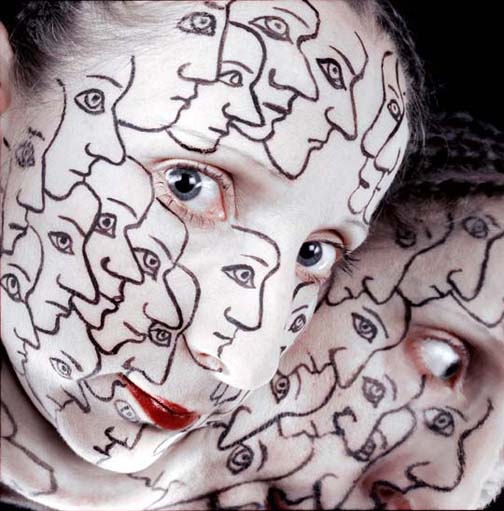
| Rimma Gerlovina and Valeriy Gerlovin, Manyness © 1990, C-print. |
A series of concepts literally passed through the looking glass when we began to deploy bending-mirror surfaces. This opened up a whole new, complex field of vision in our photography, enhancing it with dizzying kaleidoscopic imagery. Two adjoining mirrors create the visual effect of mathematical infinity. With that, we seemed to enter the realm of mind-boggling multiplication of reflections of reflections of reflections... shadowy corridors with no discernible end.
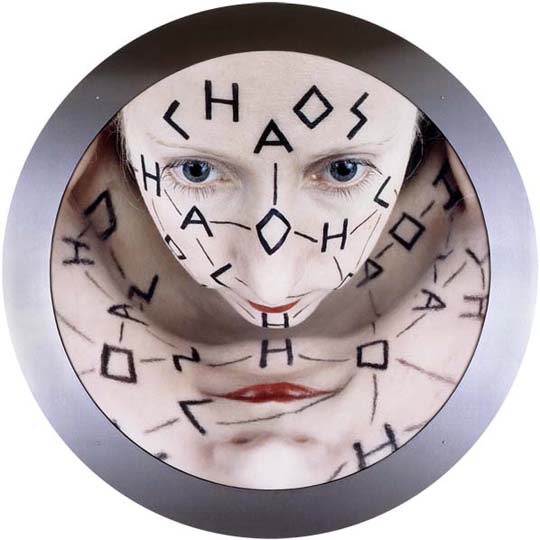
| Rimma Gerlovina and Valeriy Gerlovin, Chaos, ©1990, C-print in stainless steel frame, diam. 48". |
In the visual formula Chaos, inscribed on the face, the chemical and cosmic meaning of that word is equivalent to shaping the chaos within the self. The collective self-image is dispersed in all directions, as if being cast into the universal chaos, while in essence it's one indivisible union. Nothing is separate; division is evident only on the mirror surface. One is simultaneously the one and the all, dividing oneself into the creation of diversities in their endless reflections of pars pro toto.
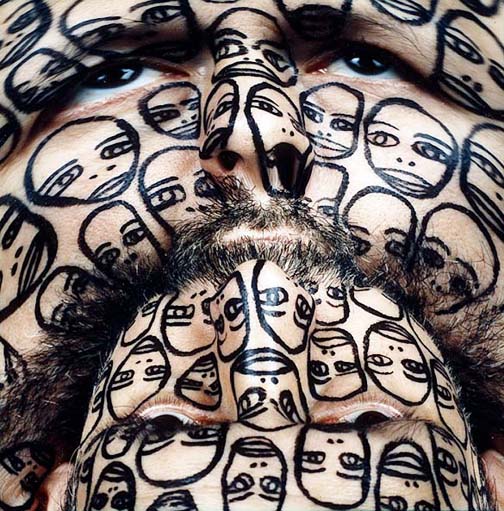
| Rimma Gerlovina and Valeriy Gerlovin, Kronos © 1990, C-print. |
Manyness (1990) and Kronos (1990) each reverberate with fractal repetition of the copious images, smoothing and hiding the features of the main face, the principal host of all these multiplex mutations. The distorted reflections create a strange polymorphic legion of singularity, giving the impression of a single crowded face. The multitude of thoughts and plurality of worlds here suggests a collective self-image, as if we were visualizing an echo, all within one, within all, within one... People are placed in the world like in a theater, whose stage extends everywhere, and where the continuous performance is always on.
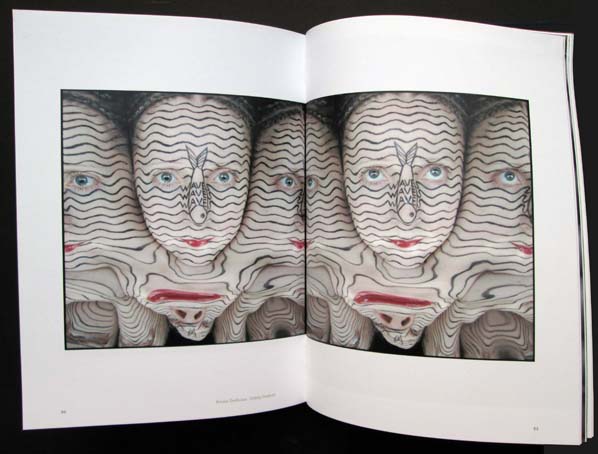
Rimma Gerlovina and Valeriy Gerlovin, W-ave-s © 1990, in book Black Forest,
Candella Books, 2014, edited by Russell Joslin, publisher of Shots magazine. Russell Joslin's photographs (their fluid nature is mystifying) can
be seen on russelljoslin.com |
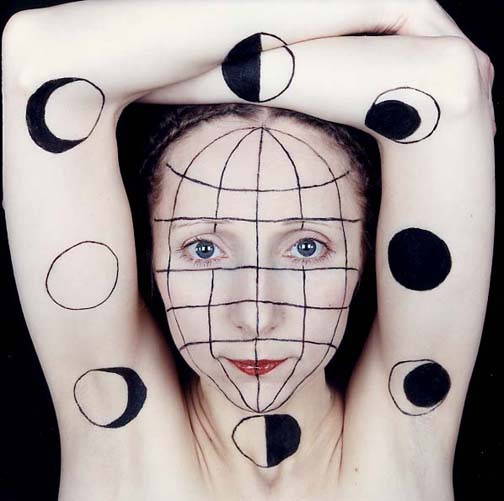
| Rimma Gerlovina and Valeriy Gerlovin, Lunation © 1990, C-print. |
Different phases of the moon beat the cyclic rhythm of Sundays and "Moondays," filling up our "moondane" activity. That recurrence is supposedly ruled by Luna's magnetism that generates live, preserves and kills it - so far, that has been the theme for many lunar mysteries of the large multinational pantheon of moon goddesses all over the world. Therefore, the moon encompasses both
![]()
The lunar illumination with its reflected silver light is gentle, blending, and virginal; it retreats into the emotional domain of the unconscious. Lost in the mist of time, the widespread doctrine of the celestial influences attributes the origin of our body to earth; but the vital principle, which nourishes earth and causes everything to grow, - to the moon. Plutarch described the universe as an "animal" or "thing" ensouled; the sun is its heart, and the moon is its liver. (2) The nutritive lunar sphere rules the vegetal aspect of existence, identical with the "astral" or subtle formative forces of the world. The moon shines with a borrowed or reflective light. And we leave, not with her eerie shining alone that has to be subdued before the intelligent clarity, which was expressed by the sun symbol in many different beliefs. The similar meaning is apparently behind the image of "a woman clothed with the sun, and the moon under her feet" (Rev. 12:1).
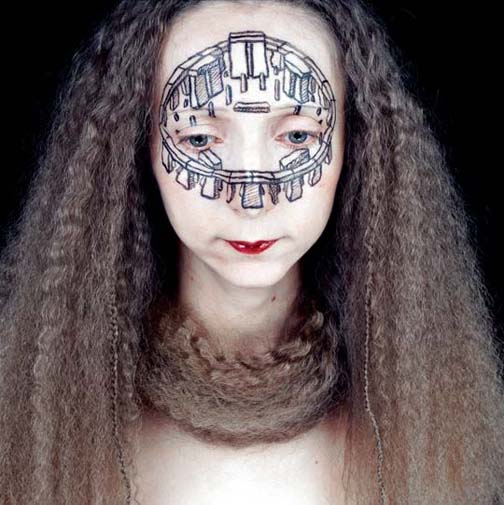
| Rimma Gerlovina and Valeriy Gerlovin, Stonhenge © 1991, C-print. |
In a "face-full replication" of the ring of megaliths from the desolate Salisbury Plain in Southern England, called Stonehenge, we tried to get across the idea of the sun cult. This relic of pre-Druidic, perhaps Orphic ceremonial rites (which this image tentatively evokes) were dedicated to sun worship, according which the grace pours into the universe through the solar door, by means of its enlightening focusing rays. The image of the Sun appeared in our work quite often taking variety of forms and psychometric characteristics.
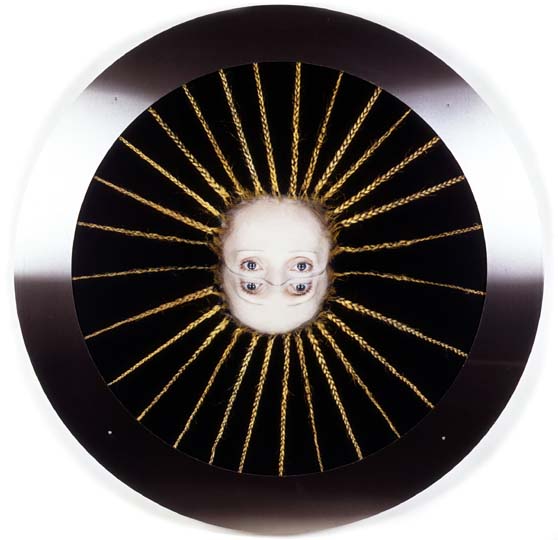
| Rimma Gerlovina and Valeriy Gerlovin, Sunrise © 1990-92, C-print in stainless steel frame, diam. 48Ó. |
In the round version of the great luminary, the braids "radiate" as the solar rays. To bring out a point of similarity, thoughts emanate both as waves and quarts, as force and things, molding everything around if they are sufficiently strong and concentrated. We cannot control randomness, but it is possible to control and discharge thoughts envisioned as things, to get rid of unpleasant moods and sticky popular concepts exactly as we get rid of ordinary garbage.
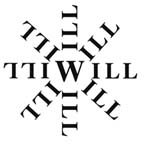
The man's "rolling head" of consciousness is like a solar ball rolling around the horizon, from the dawning East of childhood to the twilight old age of the West. Finishing thus one day, it is ready to start another one, obtaining knowledge from the superconscious region above the horizon and from the subconscious denizen of the below. The distinguished qualities of this triumphant chariot - the radiating force of mind and its great power of influence - can be tremendously constructive, but also easily misused. This type of knowledge cannot be communicated directly; it may be expressed only through symbolism and metaphors, used as a common tool in the old scriptures. Here is an example of how the rediscovered in the Renaissance old hermetic text treats a similar subject: "Because the World is a sphere, that is, a head, and above the head there is nothing material, as beneath the feet there is nothing intellectual... But the soul of man is carried in this manner; the mind is in reason, reason in the soul, the soul in the spirit, the spirit in the body...Wherefore, we must be bold to say, that an earthly man is a mortal God, and that the Heavenly God is an immortal man." (3) Just as the scenario seems to be ending; one suddenly realizes that the last line is only the beginning of a new phase of the progression.
--------------------------------------------------------------------------------------------
BIBLIOGRAPHY
Many Photoglyphs are reproduced in the books and the catalogs:
The Concepts, book,1012 (info) (link to the pdf)
Photoglyphs The New Orleans Museum of Art, 1993, (more...)
Still Performances, MIT, 1989.
Greek Formula ©1990:
Be-lie-ve ©1990:
Howard Risatti "Rimma and Valeriy Gerlovin at Robert Brown Contemporary Art", Artforum, Feb., 1991;
Interview, Shots, #89,
fall, 2005 (back cover).
Tic-Tac-Toe ©1990:
Book "Art on
the Edge and Over" by Linda Weintraub, Arthur Danto, Thomas McEvilley,1996.
True-False ©1992:
The Sciences, May-June, 1997 (cover).
Neil deGrasse Tyson "The Importance of
Being Constant", Natural History magazine, 11, 2004.
Labyrinth ©1989:
Manyness © 1990:
Textbook Abnormal
Psychology in a Changing World, Prentice-Hall, 1997.
Fecundity © 1990:
"Memory of Childhood", Helen A. Harrison, New York Times, Dec.
8, 1996.
Lunation ©1990:
Amei Wallach, "Gerlovin's "Decade of Freedom", exhibition at The Fine Arts Museum of Long Island, Newsday, May 31, 1991.
Westchester Life Style magazine (exhibition "Making Faces" at Hudson River Museum), March, 1995.
< home < content next: part 3 >